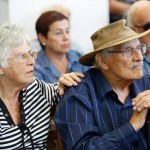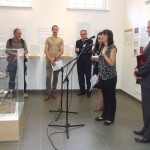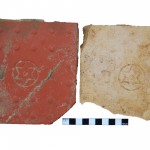The Centre of Archaeology has recently opened a new international exhibition at the site of the former Nazi extermination and labour camps in Treblinka.

The new exhibition “Finding Treblinka: An Exhibition of Forensic Archaeological Research”.
Photo credit: Jewish Historical Institute
“Finding Treblinka: An Exhibition of Forensic Archaeological Research” showcases physical evidence uncovered at both camps during a seven-year research project led by Dr Caroline Sturdy Colls. Located within the Museum of Struggle and Martyrdom at Treblinka in Poland, the permanent exhibition provides visitors with a new history of the crimes perpetrated in both camps, where almost one million people are known to have died during the Holocaust. It also features an outdoor exhibition at the labour camp and execution site, where archaeological investigations have shed new light on the nature of the Nazis’ crimes. The opening of the exhibitions took place on the 72nd anniversary of the Treblinka revolt, an event which saw approximately 200 prisoners escape from the extermination camp. The only remaining survivor of the revolt, Samuel Willenberg, attended the ceremony along with his family.
Dr Caroline Sturdy Colls who curated the exhibition along with Kevin Colls and Michael Branthwaite said:
“After seven years of carrying out research and fieldwork at Treblinka, I wanted to create a new exhibition to highlight what we have found and to give visitors a better insight into the experiences of those who were sent to both camps at Treblinka. When we discovered the remains of the gas chambers in 2013, we came across a large number of objects and remnants of the Old Gas Chamber, which are now being exhibited for the first time”.
Commenting on the outdoor exhibition at the labour camp and execution site , Dr Sturdy Colls added:
“The project team felt it was very important to tell the story of what happened in the labour camp at Treblinka as it is often overshadowed due to the sheer number of people killed at the extermination camp. New research and archaeological fieldwork has allowed us to create new information boards at the site. I was very keen to ensure that witness testimony and images played an important role on these boards to enable visitors to get a better sense of what the people held here experienced”.
The exhibition is also accompanied by a temporary artistic installation which will run for six months (until February 2016). “Finding Treblinka: Artists Respond” features the work of six artists who have responded to the archaeological findings at both the extermination and labour camps. This exhibition represents an innovative collaboration between artists and archaeologists who have sought to find alternative ways to present scientific and historical information to a wider audience. Curator Michael Branthwaite reported:
“The artists responses have been driven by their individual practice and concerns over how specialist scientific information can be communicated to a wider audience. The show focuses on how artists can create new discourses and dialogs that create change in the way we think about history and its relationship with the present. It explores how we process and build histories around objects, and how science and art can come together to enhance public knowledge about sensitive and traumatic events”.
“The artworks themselves range from text-based wall works to free standing sculpture. Re-appropriated objects also feature, such as a re-upholstered chair exhibiting motifs from the objects found during the excavations at Treblinka. Since the objects found during these excavations will remain at the site, the artworks will eventually provide a travelling surrogate, offering viewers a conversational experience that will also hopefully encourage people to visit Treblinka”.
Dr Sturdy Colls added:
“We hope that the new exhibitions at Treblinka will provide an important educational resource which will enhance public knowledge concerning the terrible atrocities perpetrated at Treblinka. Over seventy years after the events, new technologies and methods are revealing new information about what happened at the camps and we hope that the exhibition will go some way to ensuring that this important history is never forgotten”.
The exhibitions can be seen by visiting the Museum of Struggle and Martyrdom in Treblinka. The artistic exhibition runs until February 2016 and the archaeological exhibition is a permanent exhibition.
- A tour of the extermination camp given by Dr Caroline Sturdy Colls at the exhibition launch. Photo credit: Jewish Historical Institute
- New Exhibition Opens at Treblinka
- Survivor Samuel Willenberg and his wife Ada at the opening ceremony of the “Finding Treblinka” exhibitions Photo credit: Jewish Historical Institute
- Dr Caroline Sturdy Colls opening the “Finding Treblinka” exhibition Photo credit: Jewish Historical Institute
- Samuel Willenberg, the last survivor of the extermination camp at Treblinka, attending the commemoration ceremony Photo credit: Jewish Historical Institute
- “Finding Treblinka Exhibition”
- Visitors viewing the new information boards at the labour camp at Treblinka Photo credit: Centre of Archaeology
- A commemoration ceremony of Romani victims who died during the Holocaust which was followed by a tour of the new exhibition at the labour camp. Photo credit: Centre of Archaeology
- A gold pendant found during archaeological investigations at Treblinka, now displayed in the “Finding Treblinka” exhibition Photo credit: Jewish Historical Institute
- A rose brooch found during archaeological excavations at Treblinka, which is now on display in the museum Photo credit: Jewish Historical Institute
- Hair clips found during archaeological excavations at the extermination camp, which are now on display in the museum at Treblinka. Photo credit: Centre of Archaeology
- Tiles from the Old Gas Chambers which were recovered during archaeological excavations in 2013. They are now on display in the museum at Treblinka. Photo credit: Centre of Archaeology
- A Pan by Michael Branthwaite, which is exhibited as part of “Finding Treblinka: Artists Respond” Photo credit: Michael Branthwaite
- arm(c)hair by Jenny Steele, which is exhibited as part of “Finding Treblinka: Artists Respond” Photo credit: Jenny Steele
- Treblinka Finds by Hilary Jack, which is exhibited as part of “Finding Treblinka: Artists Respond” Photo credit: Hilary Jack
- Rose by Janine Goldsworthy which is exhibited as part of “Finding Treblinka: Artists Respond” Photo credit: Janine Goldsworthy
- Deep Field by Dave Griffiths, which is exhibited as part of “Finding Treblinka: Artists Respond” Photo credit: Dave Griffiths

















